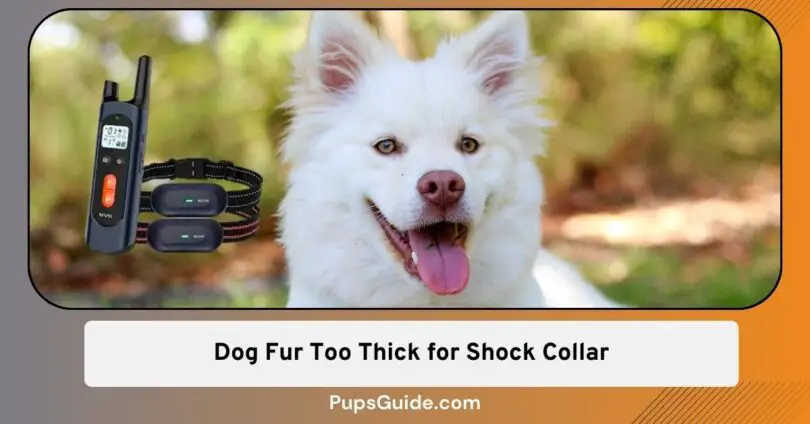You know, training a dog with a shock collar can be effective, but when your furry friend sports a lion’s mane, fitting that collar properly becomes a little tedious.
Let’s dive into the nitty-gritty of dealing with luscious fur and ensuring the shock collar does its job effectively. After all, as any seasoned dog trainer will tell you, the key to successful training starts with the right equipment.
Scroll down to read more about Dog Fur Too Thick for Shock Collar.
The Challenge of Thick Fur – Fitting the Shock Collar Right
A dog’s majestic mane presents a unique challenge – good contact. You see, with shorter-haired dogs like Bullies, strapping on a shock collar is a breeze.
But with the likes of German Shepherds and Collies, it’s a different story. Their long fur demands a more intricate approach to ensure the collar sits snugly against their skin, providing optimal effectiveness.
When training, the number one rule is to have your equipment game on point before diving into any training session.
Imagine hitting that shock button, expecting a response, and realizing there’s no proper contact – chaos ensues!
Let’s break down the process of fitting a shock collar on a furry fellow like Henry.
Step 1: Upgrading the Contact Points
The moment I lay eyes on a shock collar, the first thing I do is to swap out the standard contact points for winged ones. These little marvels are like barrettes; they thread through the fur, giving us a head start in tackling the lion’s mane. It’s a simple switch, but it makes a world of difference.
Some collars come with the longer version (¾ inches) prongs. You can use them, too.
Step 2: The Art of Proper Placement
Now, here comes the real challenge – putting the shock collar on appropriately.
No, we don’t just slap it on and start pressing buttons like we’re playing a video game. There’s an art to it, especially when dealing with thick fur.
- I start by finding the sweet spot for the collar, usually around 4 o’clock or 8 o’clock. But hold on, there’s a jungle of fur to navigate through.
- With one hand, I part the fur until I hit that pink line in the skin, folks!
- Now, holding the fur open with one hand, I slide the collar into position and, with the other hand, work my magic with the strap.
I delicately hold the fur apart with one hand, collar in position, and with my other hand, I tighten and fasten the strap. It’s a delicate dance, ensuring the collar stays put without cutting off the dog’s air supply.
And remember, it’s got to be snug but not constricting. We’re aiming for perfection here – just right!
Step 3 – Engaging the Dog:
Now, here’s where the real magic happens. With the shock collar securely in place, it’s time to engage your pet.
I love using a leash, and attaching it while they are in their designated spot. It’s like having an insurance policy against any wild shenanigans. After all, we want him focused on the training, not running around like a tornado.
Step 4 – Final Checks and Balances:
Once the collar is snugly on the dog, I make sure to lift my left hand without the collar shifting. This ensures it’s not too tight, allowing for proper breathing.
If the collar is too loose, you risk losing contact, and your training efforts go down the drain. Remember, the goal is to have a snug fit without sacrificing your dog’s comfort. More on this ahead.
Why Does Snug Fit Matters?
The snug fit on a shock collar is like tailoring a suit – it’s gotta be just right. So, why does it matter? Well, my friends, let me break it down for you.
1. Comfort is Key:
You wouldn’t want to spend your day in a too-tight pair of jeans, right? Dogs are no different.
A snug collar ensures your furry buddy can breathe easy, move freely, and focus on the training without feeling like they’re in super tight PJs. It’s comfort 101, and we all know a comfy dog is a happy dog.
2. Maintaining Control:
Now, imagine you’re at the wheel of your car, and the steering’s a bit wonky. Scary thought, isn’t it? Well, a shock collar with a snug fit is your steering wheel.
It ensures you have the control over your dog that you need, like driving down a straight road instead of swerving all over the place. In case he starts going rogue, you’ll always be there to hit that Z button and get him out of there.
3. Effective Shock Delivery:
Let’s get real – the shock collar isn’t just a fancy accessory. It’s a tool, and like any tool, it works best when used right.
A snug fit ensures those shock waves hit the right spot – the sweet spot between effective training and, well, chaos. Think of it like seasoning your food – too much or too little, and the whole dish is off. With a snug fit, you’re sprinkling just the right amount of discipline into your dog’s behavior recipe.
4. No Escape Artists Allowed:
We all know dogs have a knack for escaping, right? Once your dog slips out of a loose collar, and suddenly, your training session turns into a backyard chase scene.
Now, who needs that kind of drama? A snug collar is your canine escape-proof insurance. It stays put, keeping your dog focused and you in control. It’s like having a secure lock on the front door – no unexpected escapes allowed.
5. Building Trust:
Last but not least, let’s talk about trust. Your dog looks to you for guidance, for that bond that makes them feel secure.
A snug collar is like a reassuring hug, letting your pup know you’ve got things under control. Loose collars might make them feel uneasy like you’re not quite in charge. But with that snug fit, it’s a signal that you’ve got their back – a trust-building masterpiece.
So, there you have it – the lowdown on why a snug fit on your dog’s shock collar is the secret sauce to successful training. It’s about comfort, control, effective shocks, no escape acts, and, most importantly, building that unbreakable bond of trust between you and your furry friend.
Dog Fur Too Thick for Shock Collar? – Conclusion
So, there you have it – the art of achieving a snug fit all the while reaching the dog’s skin for effectiveness. It’s all about adapting and finding the right approach for each unique furry companion.
So, the next time you gear up for a training session, take a cue from this playbook. Upgrade those contact points, master the art of placement, and watch your training sessions transform into a harmonious dance between you and your four-legged friend.
Happy training, everyone! Until next time, keep those tails wagging and those paws learning.








Leave a Comment